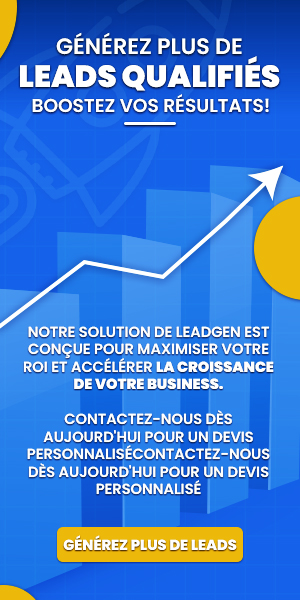Choose the right tools lead generation can make all the difference between a hesitant prospect and a loyal customer. In the digital age, the proliferation of tools available on the market makes this choice both exciting and confusing. How to navigate through this plethora of software to find the one that will promise a lead generation effective ?
The tools of lead generation are not always equal. They are distinguished by their features, their capacity tointegration, as well as their support customer. It is therefore essential to identify the specific needs of your business before making an informed choice. You will find software suitable for both B2B and B2C, each having its own approach.
Once the right tool has been selected, its use must be optimized to ensure maximum return on investment. Strategies such as automating your campaigns or analyzing the data generated can significantly boost the effectiveness of your marketing efforts. Thus, setting up a strategy well thought out will allow you to fully exploit the potential of your lead generation.
In today’s digital world, lead generation has become a crucial element for any business wishing to grow and prosper. Each interaction with a prospect can turn into a business opportunity, making it essential to use effective tools to capture the attention of potential customers. But how to choose the right tools lead generation and use them effectively to maximize your return on investment? In this article, we will explore concrete strategies, accompanied by recent data and relevant examples.
Table des matières
ToggleUnderstanding How Lead Generation Tools Work
Before diving into the sea of available software, it is crucial to understand what a lead generation tool. These software solutions are designed to identify, attract and qualify potential prospects. According to studies conducted by HubSpot, approximately 61% of marketers consider improving lead generation to be their number one priority.
Most of these tools integrate with customer relationship management (CRM) systems and provide in-depth analytics on user behavior. For example, a lead generation tool effective will track visits to your website, analyze the content that captures the most interest and adjust marketing strategies accordingly.
Essential Criteria for Choosing a Lead Generation Tool
When you start selecting a lead generation software, it is essential to ask the right questions. Here are some key criteria to consider:
- Features: What are the main characteristics of the tool? Does it support email tracking, contact segmentation and custom form creation?
- Integrations: The tool should be able to integrate with your existing solutions, such as your CRM, social media platforms, and analytics tools.
- Ergonomics: Is the user interface intuitive? Good software should be easy to use for rapid adoption by your team.
- Customer support: What type of support is offered? Access to timely support can be the difference between a successful project and a failure.
- Cost : Finally, compare prices. Make sure the chosen tool offers good value for money taking into account the features offered.
Platforms like SalesDorado allow a direct comparison of different tools based on these criteria.
Innovative Strategies for Effectively Using Lead Generation Tools
50% of marketers consider lead generation a top priority, yet 61% struggle with generating high-quality leads…
— TK Kader (@Tawheed) July 16, 2024
This discrepancy highlights a crucial issue: the lack of a proper lead generation strategy and unguided execution.
So, how do you generate high-quality leads that…
Know how to choose one lead generation tool is not enough. It is also crucial to use it optimally. Here are some innovative strategies that can boost the effectiveness of your lead generation process:
1. Process automation: Automation can save you valuable time. Use tools like HubSpot Or Marketo allows you to install automatic campaigns that nurture leads based on their online behavior.
2. A/B testing: Don’t underestimate the potential of A/B testing. Testing different messages, visuals and offers will help you determine what works best for your prospects. These variations can have a huge impact on conversion rates.
3. Monitoring of KPIs: Measure the effectiveness of your actions by monitoring key performance indicators (KPIs). According to Open Lead, 54% of companies that track their KPIs obtain more significant results. These KPIs can include cost per lead, conversion rate or even overall return on investment.
4. Multi-channel integration: Consider using a multi-channel approach. By synchronizing your efforts across different channels like social media, email marketing, and paid ads, you increase your chances of reaching more qualified prospects.
5. Networking: Direct contact is also essential. Don’t hesitate to attend conferences and industry events to promote your lead generation tools. These meetings can lead to fruitful collaborations and the discovery of new prospects.
A relevant case study is that of Wishpond, which was able to transform its strategy lead generation through multi-channel campaigns, increasing its conversion rate by 30% in a few months.
Monitor Trends and Adapt
THE lead generation tools continue to evolve. According to a recent study, the lead generation software market is expected to witness explosive growth in the coming years. Therefore, it is vital to monitor these trends and gradually integrate new features and tools into your strategy.

To stay up to date, regularly check resources like Appvizer Or Hipto to discover the latest developments in the field.
In addition, innovation in the field of lead generation is not just limited to tools. For example, applications of machine learning and predictive analytics solutions promise to transform how businesses identify and engage with their leads.
By adopting a dynamic of continuous learning and adjustment, you will be better prepared to leverage lead generation tools to drive growth in your business. Don’t overlook the importance of an adaptable perspective to navigate this ever-changing landscape.














